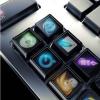Leadis Technology today announced production volume shipments of the LDS522, a 65K color OLED driver IC with integrated controller supporting 128 (RGB) x 68, 128 (RGB) x 36, and 96 (RGB) x 68 display resolutions. Engineered for mobile phone sub-displays and MP3 players, the device has achieved an initial design-win in the secondary display of a handset for a top-tier supplier.
The LDS522 offers multiple methods for display optimization, including gamma correction, luminance control, temperature variation compensation, and an EEPROM-based adjustment to address panel-to-panel process variation. The product provides a 65K color upgrade to the area-color capable LDS518 and a resolution upgrade to the LDS514 and LDS516, two of Leadis' other 65K color OLED offerings. Integrating 139k bits of full frame memory, an on-chip oscillator, and a DC/DC converter, the LDS522 is a highly-integrated SoC designed to provide vivid and accurate color images across a variety of operating conditions.
In addition, the LDS522 includes programmable display features such as area scrolling, partial display, and color depth selection for enhanced screen performance.
 Art.Lebedev gives an update on the Optimus OLED keyboard -
Art.Lebedev gives an update on the Optimus OLED keyboard - 








